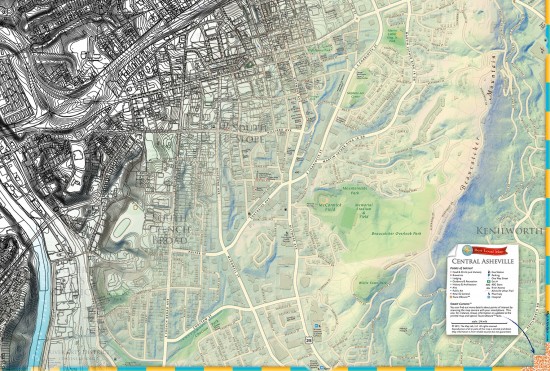The Asheville Map, the creation of Bruce and Nora Daniel, is picking up accolades at the national level, like inclusion in the NACIS Atlas of Design and a nod from WIRED Magazine. The map, which portrays in full color downtown Asheville and the surrounding region, is chock full of visual details, pinpoint accurate street info and locations of Asheville’s favorite destinations. To get to that level of detail, Bruce Daniel says he turned to open data, including the City of Asheville’s own publicly available GIS information.
“When I started thinking about this map, I started by looking around and seeing what data was available,” says Daniel, a mapmaker by trade and owner of Best Local Map. During the course of that search, he ran into City GIS Analyst Dave Michelson at a local GIS meet up and the two began talking about open data. The City was continuing to establish its open data portal, using community input from an Open Data Day to find the best candidates to include. “We were figuring out what we had that was already available and how we could make it easier to get to those data sets,” Michelson says. Working with Daniel, Michelson was able to pull up data for the city’s building footprints, Parks and Recreation facilities and more.
“He gave me an idea of what he needed. It was great timing.” Michelson says. “Open data can be an economic driver. It is information free and available to entrepreneurs, so the data sets we push onto the portal are often in response to questions from the people wanting to use it.”
Daniel says the inclusion of building footprints allowed him to create a richer visual texture to the map, and GIS data for the locations of attractions like the the Urban Trail or notable grave sites in the Riverside Cemetery make it even more useful for visitors taking in the sights.
“The whole open data movement allows us to interact with data in different ways, and I interact with it in a more artistic purpose,” Daniel says. “When a city has that information available, it is an invitation to do something with it. Open data allowed us to produce something as rich as we wanted it to be.”
